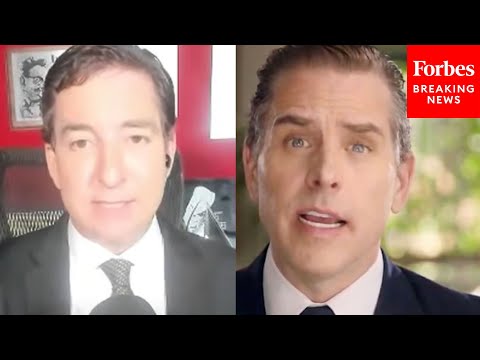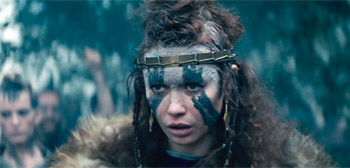29 Things We Learned from the ‘Abigail’ Commentary
Welcome to Commentary Commentary, where we sit and listen to filmmakers talk about their work, then share the most interesting parts. In this edition, Rob Hunter revisits the newest feature from Radio Silence, with their commentary for this year’s Abigail.
When it comes to the filmmaking collective known as Radio Silence, my heart belongs forever to 2019’s Ready or Not. Funny, smart, thrilling, and pitch-perfect to the very end, that film is the group’s masterpiece. That said, everything they do, from their V/H/S (2012) segment to their two Scream sequels, is a good time for fans of genre fun. Their latest feature is once more in the horror/comedy vein, and it’s once more a highly entertaining ride for fans of blood-soaked laughter.
Abigail is new to home video, and as they often do, the Radio Silence guys have packed the Blu-ray with plenty of extras including a directors’ commentary track. Their tracks are always great listens as they’re passionate filmmakers who enjoy sharing anecdotes, struggles, practical details, and more. Now keep reading to see what I heard on the commentary for…
Abigail (2024)
Commentators: Matt Bettinelli-Olpin (co-director), Tyler Gillett (co-director), Michael P. Shawver (editor)
1. The opening ballet performance was filmed at the Bord Gáis Energy Theatre in Dublin, Ireland. Alisha Weir, who plays the vampiric little girl of the title, lives in Dublin, and the theme continued as Bram Stoker — Mr. Vampire himself — grew up in the Irish city.
2. The opening was written as a series of crosscuts between Abigail’s dancing and the introduction of the crew, but for a while at least, they kept the dance in its full. It was mostly to acknowledge the work that went into the performance, but they soon realized the film was better served with the crosscuts.
3. The first preview led to notes coming down, presumably from the studios and/or producers, to cut ten minutes. “A great note,” they add.
4. They know that audiences would be seeing the film with the knowledge that Abigail is a vampire, so they leaned into the idea that they could have fun teasing out the reveal. “That last shot where she does her cool little bow down, you get the feeling right away, when credits are still going, that she’s the one orchestrating this.” This may be a conscious or subconscious realization for viewers, but it’s hopefully there.
5. Much of the film is tinted as they were filming a lot of day for night given the short nights in Ireland’s summer.
6. The house where Abigail is abducted has “a lot of history” including a gun fight and attempted coup.
7. The photos by Abigail’s bedside are the filmmakers’ (and their pets’) cameos.
8. Shawver mentions that one of the big things as an editor is to show the filmmakers that he understands the film they’re making. In essence, he’s editing for the director(s), before anyone else.
9. The actors’ strike shut the film down, and it allowed them time to edit the first two acts before returning to film the last third of the movie.
10. The first thing they shot was the scene where Joey (Melissa Barrera) takes money from each of them to tell them something about themselves. This is Radio Silence’s third film with Barrera, after Scream (2022) and Scream VI (2023), but they had only just met the other actors a few weeks earlier. So this scene where characters get to know each other, was also the directors getting to know and see the actors at work.
11. The bulk of the film was shot in Glenmaroon House despite being written to take place in an abandoned hotel. Once they found Glenmaroon, though, they and the production designer shifted it more into a mansion/hunting lodge vibe. That’s their usual pattern — they craft the story, are satisfied with the tale and the characters, and then they work out locations which, in turn, often lead to adjustments with the story. Two areas of the house are actually sets, the library and the kitchen/basement.
12. The role of Abigail was the toughest, and most nerve-wracking, one to cast, but after auditioning Weir over Zoom they knew they had their vampire girl.
13. Sammy (Kathryn Newton) watches an episode of Woody Woodpecker on TV, but they previously tried it with The Sting (1973) and the “jump the shark” episode of Happy Days (1974-1984).
14. Part of pre-production involved having Angus Cloud drawing a series of dicks which were then sent to the filmmakers so they could choose the style that would end up on Kevin Durand‘s face. “How do you make the dick land?” became the question, though, before they decided on the perfect timing.
15. It was Dan Stevens‘ choice to have his character wear those big glasses, and while it introduced complications — reflections, continuity, etc — they quickly realized that it was the right call for the character.
16. It was Weir’s idea to wipe her bloody hand across her face at 55:42.
17. There are roughly 212 utterances of “fuck” in the film, “give or take.”
18. They discussed early on the various vampire abilities made familiar in pop culture, from flying to shape-shifting and such, but they were worried about opening that door. “We wanted to make sure that you didn’t feel like, ‘wait why isn’t she just doing x, y, and z at every scene?,’ so we just didn’t make it part of this movie.”
19. Frank’s real name is Adam Barrett (Stevens), “a shout out to Adam Wingard and Simon Barrett, friends of ours,” and the filmmakers behind films like You’re Next (2011) and The Guest (2014).
20. There’s a big backstory as to why Abigail loves to dance, “but it felt like we were telling you something just to tell you something.” A wise observation that more filmmakers could learn from.
21. Cinematographer Aaron Morton raised a good point regarding vampires when he asked “Isn’t moonlight just reflected sunlight? Then why can they go out at night?” They chose to ignore the question.
22. The scene where Abigail mentally puppets Sammy with both young women dancing is set to Danzig’s “Blood and Tears,” but it was choreographed against an electric guitar version of “Swan Lake.” They love the idea of Abigail being a big Danzig fan.
23. The big fight between Joey and Frank was shot post-strike, and Universal happily afforded them more resources for it on the strength of what had already been filmed. This allowed them to bring in Wade Allen and the team at 87North to help redesign the fight choreography and subsequent stunts. Allen also had thoughts on the vampire teeth. They were made from a very sharp epoxy, sharp enough to cut skin, and Allen immediately suggested softer alternatives for action-focused scenes.
24. When it came time to trim the film, Shawver would make various cuts and then play the sequences for the directors without telling them specifically what was removed. “If it works, it works,” they add, suggesting that if they don’t miss it then it isn’t important.
25. They debated the option of not bringing Lazaar (Matthew Goode), Abigail’s father, into the film at the end, but their comparison was something like The Usual Suspects (1995) if we never got to meet Keyser Soze. Smartly, they realized that not only is it a fun final reveal, but it’s also necessary for the film’s themes of parental love and responsibility.
26. The film is dedicated to Cloud as he passed away in July, 2023, before the film had completed filming. He had signed an autograph — the cloud drawing seen above the dedication — for a crew member during his time on set, and Barrera had it printed on tee-shirts for the cast and crew when filming wrapped.
27. There are seven people credited on the editing team aside from Shawver, and he gives four of them shout outs at the end. Curiously, but I’m sure unintentionally, he shouts out the four men on the team by name but neglects the three women. So I’m gonna shout them out here — great job, Diana Yip, Michelle Inzunza, and Elaina Koutras!
28. They recorded this commentary on April 2nd, 2024, just fifteen days before the movie opened in theaters.
29. The great Larry Fessenden cameos as the radio deejay around the 17:00 minute mark, and it’s the same “character” that he gave voice to in Radio Silence’s segment in 2015’s horror anthology Southbound.
Best in Context-Free Commentary
“This movie lives or dies by its cast.”
“Downhill from here, y’all.”
“What is your favorite dick?”
“This is a Scooby Doo shot.”
“Some people spray and pray.”
“Is he sounding too much like a muppet?”
“When is The Guest 2 coming out?!”
“There’s still too many people left alive at this point in the movie.”
“We’re reaching peak absurdity.”
Final Thoughts
As mentioned above, the Radio Silence guys offer up terrific commentary tracks, and this one for Abigail is no different. They’re funny and share compliments like candy with their love and appreciation for everyone who worked on the film, and they are equally happy sharing details on the production highs and lows. It’s clear they love genre films, both watching them and making them, and it’s great to hear the positivity. Good movie, great commentary!
Read more Commentary Commentary from the archives.
Related Topics: Commentary Commentary, Horror, Radio Silence





